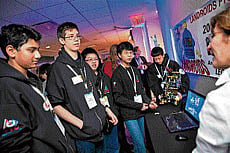
The company is getting into the science fair business with its first Google Science Fair, a global competition for teenagers that spans sciences as diverse as computer engineering, space exploration and medical technology.
The event does not have the name recognition and deep roots of the science fairs from companies like Intel or Siemens, but for most children, Google is the most familiar company of the three. With the science fair, Google aims to play an even bigger role in their lives by encouraging young scientists to experiment—and to use Google products while they are at it.
Google’s fair is different from others in a major way: entrants submit their projects online using Google products like Gmail, YouTube and Google Docs and Sites. It’s the modern-day version of showing up at the school gymnasium to demonstrate lava-spewing volcanoes or bacteria colonies in petri dishes. The goal, Google said, is for students to be able to enter even if their schools lack the resources to travel to the most prestigious fairs.
Vint Cerf, the chief Internet evangelist at Google and a science fair judge, insists that Google’s motivation is not to attract long-term customers. “The real motivation is to help stimulate kids’ interest in science and technology, and we hope infect other parts of the population in their excitement,” he said.
Google’s marketing department is overseeing the science fair; Oliveri is the head of product marketing for Google Apps. “Part of this program is helping students use the apps to discover new things and develop their hypotheses,” he said.
The strategy is similar to the one Apple used in the 1980s and early ’90s, when it outfitted school computer labs with putty-coloured computers, desktop publishing software and CD-ROM drives.
“This was a back-door approach—you get the kids focused on Apple IIs and Macs and the idea was as they grow up, they would demand them at work and in their homes,” said Tim Bajarin, a longtime computer industry analyst and president of Creative Strategies, a research firm.
“Google is mapping that in the same context, but with the basic idea that the Google online tools will represent the productivity tools of the future. Get the kids used to them in education and it becomes part of their overall lifestyle.”
Google has struggled to make inroads into offices, where Microsoft software still rules. If Google convinces high school students that its products—for example, Google Sketchup, Google Scholar and Google App Inventor—are useful, they could use them at work later on.
The strategy has already made progress with young scientists. Gabriela Aylin Farfan, a geology major at Stanford, said she started using Google Maps and Earth for field work and Google Docs for group science projects in high school.
Google reaches into schools in other ways, too, like offering free business-level apps, recruiting college students to be campus ambassadors for Google Apps and sponsoring computer science workshops for teachers.
Google winners will receive a trip to Google’s research lab in Zurich, a trip to the Galapagos with National Geographic, three days with astrophysicists at the CERN lab in Geneva or an internship at Lego.